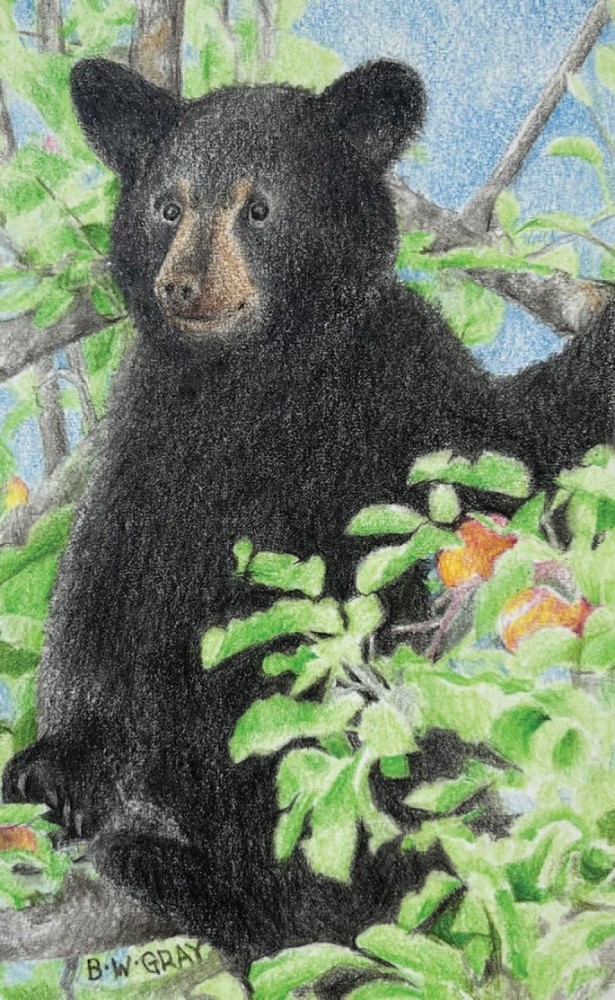When our children were small, my husband began mowing paths through our field, grassy lanes that allowed little legs to maneuver more easily through the landscape of home. Although those small children now have grown taller than I am, we keep the paths mown. One loops through the front field. Another, dubbed “Auntie EB’s Path,” heads toward my sister-in-law’s house just down the road. And the longest path leads to a giant glacial erratic we call Big Rock at the bottom of the lower field. The one that gets the most use, though, is the Apple Path.
This grassy track wends through what was, perhaps, once a neatly maintained apple orchard. Long untended, the trees are in various stages of wildness. Some have fallen over in recent years, their old trunks twisted and gnarled. Many are gangly and awkward (a bit like the teenagers I live with). Others are tall and full. Most of these trees, left unpruned for too long, have grown unruly, like wild-haired beasts, with shoots flying upward from branches at all angles and varying heights.
Some years ago, as winter merged to spring, I pruned a few of the trees, cutting off new shoots and sawing away tired old branches. I vowed to get to each tree – nearly three dozen in total. But it was hard work after so many years of neglect; I was indecisive about which limbs to prune and which to keep. And so the orchard remains mostly wild.
The woman we bought the house from, nearly two decades ago now, told us these were Prohibition trees, planted to grow fruit for making hard cider. The house was built in 1929 – near the tail end of Prohibition – and I wonder if the trees were here before the house, planted by some thirsty farmer down the road.
We have watched many seasons shift through the old orchard. In mid-spring, the trees produce a glorious display of pastel blooms. At first, the small, tightly whorled buds of palest pink appear, then a few blossoms unfold here and there. Eventually, an explosion of flowers transforms the field into a sweet-smelling froth of white and pink. Bees buzz through the apple trees then, harvesting nectar.
By the time the flowers have gone, the landscape around the orchard has greened toward summer, and our attention has shifted to other things – hiking tall mountains, tending the garden, swimming in the river. But come fall, the apple trees stand out again – not so much for their foliage, which frankly, is rather blah, but for the abundance they hold.
Some of the trees bear red fruit, others yellow. The apples don’t grow large, and most of them are spotted and misshapen, but they are ample in number. During the years the kids were in preschool and kindergarten – and unencumbered by homework and soccer practice – we gathered enough apples to make cider (not the hard kind) and applesauce. Sometimes, as I’m walking along the Apple Path, I’ll pick one to nibble. And our apple-loving dog often snags the low-hanging or fallen fruit and chews happily – flesh, stem, seeds, and all.
Mostly, though, these trees feed the wildlife. We have seen an array of animals traveling the Apple Path: turkeys, bears, deer, foxes, porcupines, coyotes, squirrels, crows. There is a well-trodden track leading from the densest cluster of apple trees, down through the lower field and into the forest beyond.
It is not unusual, on an early fall day, to spot a bear – or two or three – in an apple tree’s branches, or loitering by its trunk. Even when we don’t see the animals, we know they’ve been by – and we have to watch our step to avoid large piles of bear scat.
Several years ago, when my own cubs were still tiny, there was a mother bear with four cubs in the neighborhood. When we inadvertently startled them one evening, she sent all four up a tall, scraggly apple tree just behind the vegetable garden. While the cubs peered out from the branches, mother bear looked us over and, after seeming to realize we meant no harm, returned to noshing on windfall apples.
Come late fall, when most of the remaining apples have fallen to the ground, the animals still come through the orchard. Their tracks press into the crusty, half-frozen grass along the Apple Path. Past experience tells me the deer, especially, will continue seeking out apples as far into the winter as they can, scratching through the snow to find them.
When the snow becomes too deep, the deer keep to their sheltered, hidden places. The bears, too, have hunkered down by then, hopefully well fed on fall’s bounty. Winter’s starkness will reveal the bones of the old trees, and as I slide through the orchard on my skis, I’ll think again of pruning them – someday.



Discussion *